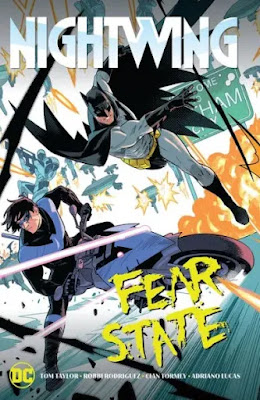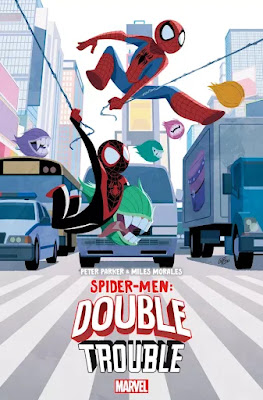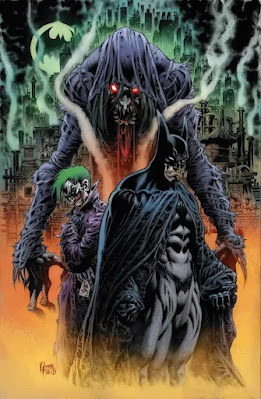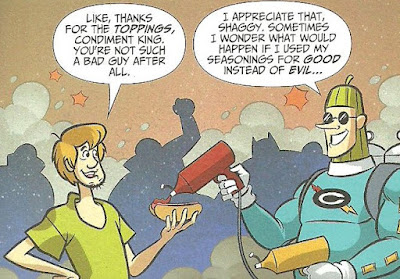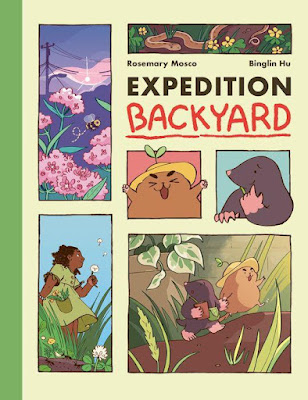Post-apocalypse, the food truck business isn't great, but that doesn't stop the mysterious Gordon from trying to ply his trade. He finds at least one incredibly hungry mouth to feed when his tricked-out food truck—nitrous and hidden cannons are a must in this world—nearly runs over a mysterious naked girl named Arisa. She's on the run from a heavily-armed militia, and Gordon adopts her, doing his best to protect her...not that she seems to need much in the way of protection, given her formidable fighting skills. Together they roam the wastelands, attempting to sell sandwiches, avoid pursuit and even stand-up for the oppressed.
DC Comics doesn't use the "What If...?" formulation in the titles of their alternate universe stories—that's a Marvel thing—but the premise of this Elseworlds story could be articulated as "What If...the DC Universe was set in a Tolkein-esque fantasy realm?" The creation of writer Alan Grant, the 2001 fully-painted hardcover begins, as all good fantasy stories do, with a map.
That map imagines a world bigger than the one actually presented in the comic that follows, with more suggestive place names than are ever actually visited by the characters, but includes the kingdoms of Amazonia, Kryptonia and The Gotham Crags, in which medieval versions of familiar DC superheroes dwell. (In this respect, Riddle of The Beast seems to be one of several Elseworlds stories to prefigure Tom Taylor and company's Dark Knights of Steel, which I've yet to read).
The story is a fairly simple one, its oomph coming more from its reimaginations of familiar characters in a new setting rather than intricate or inventive plotting. After a world-wide battle against the ultimate evil in the form of The Beast—here, Etrigan the Demon—the various rulers and warriors retreated to their own corners and their own concerns. When the Beast begins to stir again, the young Robin Drake is summoned by the wise old Riddler, who gives the boy three riddles and the task of reuniting the reluctant world against the threat.
Along the way, Robin encounters familiar names in peculiar new designs. Zatanna, a girl with a mysterious power travelling with her father; Green Arrow, a lion-faced archer and bounty hunter; Katar Hol and Shayera Tal, bird-headed, winged hawkpeople and so on. After several adventures in several different cities and wildernesses, Robin is successful. The various heroes all unite against The Beast and his undead army, and they are more powerful than ever, thanks to Robin's solution to the cryptic riddles.
Such Elseworlds projects tend to live and die by their artwork, and this book has some great art in its DNA, thanks to the character designs of Michael Wm. Kaluta. If a Kaulta-drawn, Grant-written epic fantasy sounds amazing, I hate to disappoint you, but Kaluta only offers character designs. The plan for the book was apparently always "to showcase many different painting styles" and thus be the work of "a diverse group of artists." That's according to the backmatter which shows off Kaluta's designs.
, but they do end up sharing a very large bed in a hotel after they miss the bus home from the gang's snowboarding trip. During the intense, but obviously chaste, night, Manbagi confesses her love, er, her
to Tadano in her sleep. This leads to a climactic chapter where the incredibly dense Tadano reviews the entirety of their relationship, and still can't quite bring himself to think that Manbagi might really like him.
That's the big event in this twentieth volume of the series, which I'm happy to say doesn't seem to have resolved the Komi/Tadano/Manbagi love triangle as I thought and feared it had earlier, meaning maybe there is yet a long, long life left in this series. I hope so. As I've said before, it's my favorite current manga series.
Mickey Mouse: The Ice Sword Saga Book 1 (Fantagraphics) I was looking at Fantagraphics' Disney offerings of late (see above), and curious if there was anything like
Byron Erickson and Giorgio Cavazzano's Donald Duck and Uncle Scrooge: World of the Dragonlords, in which the ducks find themselves plunged into an alternate dimension of fantasy adventure, and this one seemed to fit the bill. Part of the publisher's Disney Masters collection celebrating the work of cartoonist Massimo De Vita, it's a Christmastime epic in which Mickey Mouse and Goofy journey to an alternate dimension of fantasy adventure.
That dimension is the world of Argaar, and it's vaguely based—or at least heavily inspired by—Norse mythology. It's ruled over by the literal iron fist of The Prince of Mists, a neat character creation whose very body was once destroyed in a past conflict, and he must now wear a metal apparatus to hep give himself form and interact with his lackeys.
The story of The Prince is told to readers—and retold to the poor, over-taxed villagers of Ululand, by the conical-hatted, white bearded sage Yor. Apparently the Prince was bested once before by a legendary hero from another world named Alph, who wielded the equally legendary ice sword. If they are to thwart the Prince again, Yor reasons, they will need to send an emissary to another world in search of Alph.
A hapless volunteer is chosen to operate the world-travelling doohickey, and he promptly lands in Mickey's yard on Christmas Eve, soon returning to his world with Mickey and Goofy in tow. Too scared and embarrassed to try another attempt, he's willing to settle for the pair as otherworldly heroes, and they feel badly enough for the villagers to go along, even if it means telling a lie—that Goofy, the taller and thus the most likely to be heroic of the two, is actually Alph's cousin.
Elaborate backstory and set-up handled within the first 30-page chapter, our heroes become the core of an ever-changing campaign party that must travel the world laid out on a map, pursued by the Prince's forces as they encounter various challenges.
It's a fleetly moving, practically singing, light-hearted adventure story full of incident but light on actual violence, prodded along by De Vita's jaunty character designs, energetic linework, and elaborately detailed backgrounds and location. It reads like Tolkein by way of Peyo, without any of the drag on the action that can characterize Tolkein's own epics.
The book actually features two distinct adventures in the world of Argaar. In the first Mickey and Goofy quest for the titular sword to defeat the Prince of Mists with the help of a handful of locals. In a sequel, set on the following Christmas Eve, Yor summons them back to his world in order to save Ululand from a massive volcano, a feat what will involve once again passing Goofy of as a great hero, and he must compete in a series of games against other knights and champions from around the world in order to win the prize, a special volcano-stopping maguffin.
As with the other books in the series, there's backmatter that includes a four-page biography of De Vita...and, perhaps more appealing to a reader whose enjoyed what they just read, an ad for other Disney Masters volumes and Fanta's various Disney offerings. I'm assuming I'll be talking about some of these in next month's column.
Mickey Mouse: Zombie Coffee (Fantagraphics) French cartoonist and animator Regis Loisel presents a brand-new Mickey Mouse adventure, set in the character's 1930s golden age and presented in a format that evokes the daily comic strips of Floyd Gottfredson.
Down on their luck and out of work, Mickey and best friend Horace Horsecollar can't seem to get hired by the local tyrannical foreman, and so they take off for the country to spend some time camping with Minnie, Clarabelle and friend Donald Duck (making a rare-ish appearance in a Mouseton story arc). When they return, they find a whole bunch of trouble.
Upstate banking tycoon Rock Fueler has diabolical plans for the city, including razing their neighborhood to build a golf course. He's not exactly playing fair in his plans to convince the locals to go along, either. Among his employ are not only perennial Mickey villains Pete and Sylvester, but also a pair of clever chemists who have created a new brew of coffee, Zomba Coffee, that zombifies their male employees (females and children are dispossessed of their homes, and sent to live in a free boarding house).
Upping the ante, the chemists also come up with a stupefyingly aromatic burger recipe that victims will pay anything to acquire, meaning the workers paychecks end up back in the pockets of their employer Mr. Fueler, not unlike the way certain employers used to operate, taking care of all the needs of their workers in what amounted to a form of indentured servitude.
Luckily for Mouseton, this is the two-fisted, hard-fighting version of Mickey Mouse, and he and his friends aren't about to let Fueler and his cronies get away with their plans. Many rollicking fist-fights and a few cartoonish twists and turns punctuate an adventure that instantly reads as much like a classic as the many works of Gottfredson, Carl Barks, Don Rosa and many other Disney masters that Fantagraphics publishes. For fans of great comics, I'd give it my highest possible recommendation.
Nightwing: Fear State (DC Comics) "This is bad timing," writer Tom Taylor has Nightwing narrating in the first issue of the second collected volume of the still-new series. He's referring to the fact that he just had Dick Grayson publicly announce his commitment to Bludhaven—and, one imagines, all the work he did to set up the premise and plotting of the series—in the first volume, only to have the character drop everything and leave for Gotham City to participate in a Batman event crossover, the one that gives this volume its sub-title: "Fear State."
At least the book admits that it gets it.
While the volume doesn't advance any of the plotting of the first—accept, perhaps, as regards the relationship between Nightwing and sometimes-Batgirl Barbara Gordon—it does, taken as a whole, work as an exploration of Nightwing's place in the Batman family and how he relates to his various brothers and sisters.
The first three issues are the official "Fear State" tie-in, which functions as a sort of B-plot explaining what much of the Bat-family was up to while Batman was tackling the Peacekeepers and Scarecrow. Nightwing is tricked into a trap by a corrupted Oracle message, and rescued by Batman. From there he teams up with Barbara, and then Robin Tim Drake and then Batgirls Cassandra Cain and Stephanie Brown. Their after the person who attacked and took over Oracle's system, which leads them to Simon Saint's airborne HQ (the results of this attack show up briefly in the Batman issues of "Fear State"). These issues are all drawn by Robbi Rodriguez.
That's followed by Nightwing Annual 2021 #1 by Taylor and artists Cian Tormey, Daniel HDR and Raule Fernandez. Entitled "Blood Brothers," it features an extended team-up with Red Hood Jason Todd, including a flashback to a time when Jason was Robin and the two also teamed-up. There's footage of Todd attacking and killing a gangster who had just turned FBI informant, and killing several undercover agents in the process, and Nightwing needs to make sure it wasn't actually Jason and, once that's done, figure out who it was.
It is, rather unimaginatively, Clayface, who posed as Jason during "Hush". Well, it's a Clayface. It's not Basil Karlo or Matt Hagen or Sondra Fuller, the Clayfaces with the shape-shifting powers, but Preston Payne, Clayface III and the one without such powers. Taylor assigns him the look of Karlo and Hagen, and the artists draw him as Batman: The Animated Series' Hagen. I suppose Taylor made the choice because he wanted
The final story in the collection isn't by Taylor but rather by Tini Howard, working with artist Christian Duce. Rather than the pages of Nightwing, this one comes from an issue of Batman: Urban Legends, but it fits in perfectly with the collection, its plot semi-related to "Fear State" (some Scarecrow henchmen are using a truck full of fear gas to continue the incarcerated Scarecrow's agenda) and focuses on Nightwing as a member of the Bat-Family.
It's Christmas Eve, and the Bat-Family is all gathered at Bruce Wayne's brownstone to celebrate...all except Nightwing, whose after the Scarecrows. He's extra-focused on work, and not too excited about Christmas this year, as it's the first without Alfred. Howard uses the fear gas' hallucinatory effects to plunge Nightwing into a Charles Dickens' "Christmas Carol" riff, as he's visited by the Batgirls of Chrimstmas Past, Present and Future.
Howard accomplishes a nice balance between the mandatory superhero action and the more fun, less-often seen Bat-family-doing-family-stuff-stuff. Its' a great story, and, in quality as well as subject matter, seems to be of apiece with what Taylor was doing with the monthly series.
Superman: Action Comics Vol. 1: Warworld Rising (DC) Writer Phillip Kennedy Johnson does an effective job of making old Superman villain Mongul seem like a new, fresh and genuine threat, essentially Darkseid-izing him by simply taking his time in revealing aspects of the character and his world, building up a religious-like fervor among his followers and the impression of omnipotence.
It helps that Superman's son Jon Kent, who lived for a time in the far future with the Legion of Super-Heroes, knows from the future historical records that his dad disappears sometime soon-ish, implying that this adventure may be the Man of Steel's last.
As for the plot, a refugee ship from Warworld crashlands on Earth; a girl aboard it has the Superman symbol tattooed onto the palms of her hands and is overheard whispering an ancient Kryptonese prayer. Could she and her people somehow be survivors of Krypton? The crash causes another conflict too, as its mysterious, dangerous power source is claimed by Atlantis—the ship having crashed into the sea—but the United States wants it too, and the two nations are on the brink of all-out war for it.
Superman resolves to go to Warworld to rescue its slaves, and he wants to bring the Justice League with him, but they're reluctant to leave the planet given the tensions between the U.S. and Atlantis. Luckily, Superman built up his own, new team in the pages of Superman and The Authority.
I read the Grant Morrison-written, Mikel Janin-drawn Superman and The Authority first, and though they're technically supposed to interlock, they don't quite line-up tonally or in the little details. Though Superman is shown to be weakening for some mysterious reason in Action, he still seems much stronger than he is in Superman and The Authority, and Janin's design for the character is so radically different, including gray temples and a brand-new costume, that I at first took that book to be out-of-continuity. In the pages of Action, Superman looks like his regular self, complete with his classic costume and jet-black hair.
Both books are good, I'd even say great, but they don't align too terribly well.
Superman and The Authority (DC) This is an extremely curious book, reading very much like the first arc of a series that doesn't actually exist. Technically it continues into the pages of
Action Comics, and takes place between scenes of that series, but writer Grant Morrison and artist Mikel Janin have created a book so thoroughly divorced from the regular old DC Universe that feels and looks out-of-continuity, complete with a scene of Superman having a meeting with President John F. Kenney (he was time-lost, he explains, allowing it to technically fit into continuity or to fit into a continuity where Superman's been around since 1938, whichever the reader prefers) and has a completely different look than in his other comics, including gray temples and a new costume ("Like the
dog dug up my dad," Lois describes his "
fading powers look").
The connection to Action doesn't become apparent until the very end of the book; Morrison presents Superman's assembling of a new, non-Justice League team as the fulfillment of his promise to Kennedy, and that he has a grand project to make the world a better place in mind with them.
He recruits his old enemy Manchester Black, himself an analogue to The Authority's Jenny Sparks, and the leader of the faux-Authority team known as The Elite from Joe Kelly's classic "What's So Funny About Truth, Justice and The American Way?" from 2001's Action Comics #775, and together they assemble a team consisting of Steel Natasha Irons, Midnighter and Apollo and The Enchantress, with two new characters, a new version of OMAC and a new version of Lightray, appearing only at the climax.
While Superman's putting together his team, two classic enemies of his have teamed up in an attempt to destroy him once and for all, and recruited several other villains and anti-heroes to their cause.
Despite the title, the comics it most reminded me of were Morrison's All-Star Superman (perhaps given how much of it is set in a Fortress of Solitude, here re-named "Fort Superman" and Janin's clean lines and simple, spacious backgrounds) and Seven Soldiers (particularly The Enchantress section, where Morrison essentially recreates the character to suit himself). If that's not a recommendation to check out a super-comic, I don't know what it.
It's just too bad this is only a miniseries, and that it continues elsewhere, by a different creative team. Morrison's take on Superman is always a charming one to visit, and it would make for a heck of an ongoing series.
REVIEWED:
Secret Reverse (Marvel Etertainment/Viz Media) Before his tragic and somewhat mysterious death, Yu-Gi-Oh! creator and manga-ka Kazuki Takahashi created an Iron Man/Spider-Mann team-up for Marvel, his attempts at making a Western-style comic book leading to a sort of American super-comic/manga fusion. You can read more about it
here.





